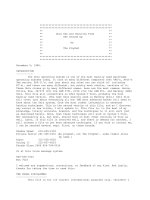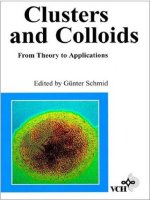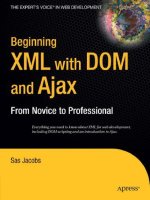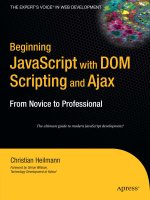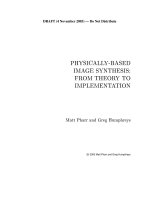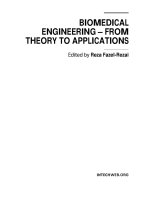Cryptography and security from theory to applications
Bạn đang xem bản rút gọn của tài liệu. Xem và tải ngay bản đầy đủ của tài liệu tại đây (9.49 MB, 512 trang )
Free ebooks ==> www.Ebook777.com
www.Ebook777.com
Free ebooks ==> www.Ebook777.com
Lecture Notes in Computer Science
Commenced Publication in 1973
Founding and Former Series Editors:
Gerhard Goos, Juris Hartmanis, and Jan van Leeuwen
Editorial Board
David Hutchison
Lancaster University, UK
Takeo Kanade
Carnegie Mellon University, Pittsburgh, PA, USA
Josef Kittler
University of Surrey, Guildford, UK
Jon M. Kleinberg
Cornell University, Ithaca, NY, USA
Alfred Kobsa
University of California, Irvine, CA, USA
Friedemann Mattern
ETH Zurich, Switzerland
John C. Mitchell
Stanford University, CA, USA
Moni Naor
Weizmann Institute of Science, Rehovot, Israel
Oscar Nierstrasz
University of Bern, Switzerland
C. Pandu Rangan
Indian Institute of Technology, Madras, India
Bernhard Steffen
TU Dortmund University, Germany
Madhu Sudan
Microsoft Research, Cambridge, MA, USA
Demetri Terzopoulos
University of California, Los Angeles, CA, USA
Doug Tygar
University of California, Berkeley, CA, USA
Gerhard Weikum
Max Planck Institute for Informatics, Saarbruecken, Germany
www.Ebook777.com
6805
David Naccache (Ed.)
Cryptography and Security:
From Theory toApplications
Essays Dedicated to Jean-Jacques Quisquater
on the Occasion of His 65th Birthday
13
Volume Editor
David Naccache
École normale supérieure
Département d’informatique
45 Rue d’Ulm
75231 Paris Cedex 05, France
E-mail:
ISSN 0302-9743
e-ISSN 1611-3349
ISBN 978-3-642-28367-3
e-ISBN 978-3-642-28368-0
DOI 10.1007/978-3-642-28368-0
Springer Heidelberg Dordrecht London New York
Library of Congress Control Number: 2012931225
CR Subject Classification (1998): E.3, K.6.5, D.4.6, C.2, J.1, G.2.1
LNCS Sublibrary: SL 4 – Security and Cryptology
© Springer-Verlag Berlin Heidelberg 2012
This work is subject to copyright. All rights are reserved, whether the whole or part of the material is
concerned, specifically the rights of translation, reprinting, re-use of illustrations, recitation, broadcasting,
reproduction on microfilms or in any other way, and storage in data banks. Duplication of this publication
or parts thereof is permitted only under the provisions of the German Copyright Law of September 9, 1965,
in its current version, and permission for use must always be obtained from Springer. Violations are liable
to prosecution under the German Copyright Law.
The use of general descriptive names, registered names, trademarks, etc. in this publication does not imply,
even in the absence of a specific statement, that such names are exempt from the relevant protective laws
and regulations and therefore free for general use.
Typesetting: Camera-ready by author, data conversion by Scientific Publishing Services, Chennai, India
Printed on acid-free paper
Springer is part of Springer Science+Business Media (www.springer.com)
Free ebooks ==> www.Ebook777.com
www.Ebook777.com
Preface
I met Jean-Jacques Quisquater at Crypto 1992, one of my very first conferences
in cryptography. I still remember the discussion we had that evening on DES
exhaustive search and on modular reduction algorithms. As a young researcher
I was impressed by the flow of information coming out of Jean-Jacque’s mouth:
algorithms, patents, products, designs, chip technologies, old cryptographic machines... to an external observer the scene would have certainly reminded of
Marty McFly’s first encounter with Dr. Emmett Brown.
Twenty years later, here I sit, writing the preface to this volume dedicated
to Jean-Jacques’s retirement. Nonetheless, one might wonder what retirement
actually means for Jean-Jacques... While emeritus, Jean-Jacques continues to
conduct research with great passion, keep a regular contact with his friends in
the research community, attend conferences, serve as an elected IACR director,
write research papers and sermon young researchers about the quality of their
work. He regularly visits MIT and UCL-London and in his very active retirement
he continues to teach the Number Theory course at UCL and consult for several
companies.
As it would be very hard to provide here a thorough account of Jean-Jacques’s
r´esum´e, let me just mention some of his career highlights. Jean-Jacques was the
first to implement DES in a smart-card (TRASEC project in 1985). For doing so,
Jean-Jacques can be legitimately regarded as the researcher who first introduced
cryptography into the smart-card industry. After working on the DES, Jean-Jacques
turned his attention to implementing RSA in smart-cards. He started by proposing a technique that improved RSA execution speed by a factor of 250,000 on 8-bit
processors (Intel 8051 and Motorola 6805) 1 . In 1986 computing an RSA 512 on
such processors took about two minutes. Consequently, it was impossible to envision any useful deployment of RSA in smart cards2. Jean-Jacques rolled up his
sleeves and launched the CORSAIR (Philips) project, that in a way reminds us of
the celebrated DeLorean DMC-12 modified into a time machine 3 : Jean-Jacques
started by adding up the effects of the Chinese Remainder Theorem and those
of a new modular multiplication algorithm (now called Quisquater’s algorithm4 ).
1
2
3
4
The very attentive reader might note that 6805 is a very special number in this LNCS
volume...
Interestingly, the situation is very similar to the implementation of fully homomorphic
cryptosystems in today’s 64-bit quad-core processors!
For the young generation of cryptographers who did not see the movie and for the
older generation who does not remember it anymore: the car’s time displacement was
powered by nuclear fission using plutonium which poured 1.21 gigawatts into a device
called the “flux capacitor”.
On which the reader will find an interesting paper in the present volume.
VIII
Preface
Then he stripped the frequency divider off the device, added a hardwired 8 × 8-bit
multiplier and got sub-second performance (500 factor speed-up).
This did not fully satisfy Jean-Jacques. Hence, in episode II (aware of competing efforts by Biff Tannen, another silicon manufacturer), Jean-Jacques launched
the FAME project, to squeeze out of the device an extra 500 factor. The algorithm was refined, the clock accelerated by a factor of 16, double-access RAM
was added and the multiplier’s size was extended to 16 and then to 32 bits. All
in all, thanks to Jean-Jacques’s efforts, by 1996 (i.e., in 10 years) a speed-up
factor of 250,000 was achieved, thereby exceeding Moore’s law provisions. This
stimulated research and opened commercial perspectives to other firms who eventually came up with creative alternatives. Until today, Philips (now NXP) uses
Quisquater’s algorithm. The algorithm was duplicated in about one billion chips,
most notably in around 85% of all biometric passports issued as I write these
lines.
Jean-Jacques’s contributions to our field are considerable. Jean-Jacques filed
fundamental smart-card patents, authored more than 150 scientific papers in
graph theory and in cryptology and coached an entire generation of UCL cryptographers. The GQ protocol (another saga that we cannot recount for lack
of space) bears his name. QG is used daily for authenticating data exchanges
throughout the world by more than 100 million machines. Jean-Jacques received
many prestigious honors and marks of recognition from foreign and Frenchspeaking institutions.
When I asked colleagues to contribute to this volume the response was enthusiastic. The contributions came from many countries and concerned nearly all
the fields to which Jean-Jacques devoted his efforts during his academic career.
The authors of these contributions and I would like to thank Jean-Jacques
for his creativity and life-long work and to thank Springer for giving us the
opportunity to gather in this volume the expression of our gratitude to JeanJacques.
October 2011
David Naccache
Table of Contents
Personal Tributes and Re-visits of Jean-Jacques’s
Legacy
The Hidden Side of Jean-Jacques Quisquater . . . . . . . . . . . . . . . . . . . . . . . .
Micha¨el Quisquater
1
On Quisquater’s Multiplication Algorithm . . . . . . . . . . . . . . . . . . . . . . . . . . .
Marc Joye
3
A Brief Survey of Research Jointly with Jean-Jacques Quisquater . . . . . .
Yvo Desmedt
8
DES Collisions Revisited . . . . . . . . . . . . . . . . . . . . . . . . . . . . . . . . . . . . . . . . . .
Sebastiaan Indesteege and Bart Preneel
13
Line Directed Hypergraphs . . . . . . . . . . . . . . . . . . . . . . . . . . . . . . . . . . . . . . . .
Jean-Claude Bermond, Fahir Ergincan, and Michel Syska
25
Symmetric Cryptography
Random Permutation Statistics and an Improved Slide-Determine
Attack on KeeLoq . . . . . . . . . . . . . . . . . . . . . . . . . . . . . . . . . . . . . . . . . . . . . . .
Nicolas T. Courtois and Gregory V. Bard
35
Self-similarity Attacks on Block Ciphers and Application to KeeLoq . . . .
Nicolas T. Courtois
55
Increasing Block Sizes Using Feistel Networks: The Example
of the AES . . . . . . . . . . . . . . . . . . . . . . . . . . . . . . . . . . . . . . . . . . . . . . . . . . . . . .
Jacques Patarin, Benjamin Gittins, and Joana Treger
67
Authenticated-Encryption with Padding: A Formal Security
Treatment . . . . . . . . . . . . . . . . . . . . . . . . . . . . . . . . . . . . . . . . . . . . . . . . . . . . . .
Kenneth G. Paterson and Gaven J. Watson
83
Asymmetric Cryptography
Traceable Signature with Stepping Capabilities . . . . . . . . . . . . . . . . . . . . . .
Olivier Blazy and David Pointcheval
108
Deniable RSA Signature: The Raise and Fall of Ali Baba . . . . . . . . . . . . . .
Serge Vaudenay
132
Free ebooks ==> www.Ebook777.com
XII
Table of Contents
Autotomic Signatures . . . . . . . . . . . . . . . . . . . . . . . . . . . . . . . . . . . . . . . . . . . .
David Naccache and David Pointcheval
143
Fully Forward-Secure Group Signatures . . . . . . . . . . . . . . . . . . . . . . . . . . . . .
Benoˆıt Libert and Moti Yung
156
Public Key Encryption for the Forgetful . . . . . . . . . . . . . . . . . . . . . . . . . . . .
Puwen Wei, Yuliang Zheng, and Xiaoyun Wang
185
Supplemental Access Control (PACE v2): Security Analysis of PACE
Integrated Mapping . . . . . . . . . . . . . . . . . . . . . . . . . . . . . . . . . . . . . . . . . . . . . .
Jean-S´ebastien Coron, Aline Gouget, Thomas Icart, and
Pascal Paillier
207
Side Channel Attacks
Secret Key Leakage from Public Key Perturbation of DLP-Based
Cryptosystems . . . . . . . . . . . . . . . . . . . . . . . . . . . . . . . . . . . . . . . . . . . . . . . . . . .
Alexandre Berzati, C´ecile Canovas-Dumas, and Louis Goubin
EM Probes Characterisation for Security Analysis . . . . . . . . . . . . . . . . . . . .
Benjamin Mounier, Anne-Lise Ribotta, Jacques Fournier,
Michel Agoyan, and Assia Tria
An Updated Survey on Secure ECC Implementations: Attacks,
Countermeasures and Cost . . . . . . . . . . . . . . . . . . . . . . . . . . . . . . . . . . . . . . . .
Junfeng Fan and Ingrid Verbauwhede
Masking with Randomized Look Up Tables: Towards Preventing
Side-Channel Attacks of All Orders . . . . . . . . . . . . . . . . . . . . . . . . . . . . . . . .
Fran¸cois-Xavier Standaert, Christophe Petit, and
Nicolas Veyrat-Charvillon
233
248
265
283
Hardware and Implementations
Efficient Implementation of True Random Number Generator Based on
SRAM PUFs . . . . . . . . . . . . . . . . . . . . . . . . . . . . . . . . . . . . . . . . . . . . . . . . . . . .
Vincent van der Leest, Erik van der Sluis, Geert-Jan Schrijen,
Pim Tuyls, and Helena Handschuh
300
Operand Folding Hardware Multipliers . . . . . . . . . . . . . . . . . . . . . . . . . . . . .
Byungchun Chung, Sandra Marcello, Amir-Pasha Mirbaha,
David Naccache, and Karim Sabeg
319
SIMPL Systems as a Keyless Cryptographic and Security Primitive . . . .
Ulrich R¨
uhrmair
329
www.Ebook777.com
Table of Contents
Cryptography with Asynchronous Logic Automata . . . . . . . . . . . . . . . . . . .
Peter Schmidt-Nielsen, Kailiang Chen, Jonathan Bachrach,
Scott Greenwald, Forrest Green, and Neil Gershenfeld
A Qualitative Security Analysis of a New Class of 3-D Integrated
Crypto Co-processors . . . . . . . . . . . . . . . . . . . . . . . . . . . . . . . . . . . . . . . . . . . . .
Jonathan Valamehr, Ted Huffmire, Cynthia Irvine, Ryan Kastner,
Cetin
¸
Kaya Ko¸c, Timothy Levin, and Timothy Sherwood
XIII
355
364
Smart Cards and Information Security
The Challenges Raised by the Privacy-Preserving Identity Card . . . . . . . .
Yves Deswarte and S´ebastien Gambs
383
The Next Smart Card Nightmare: Logical Attacks, Combined Attacks,
Mutant Applications and Other Funny Things . . . . . . . . . . . . . . . . . . . . . . .
Guillaume Bouffard and Jean-Louis Lanet
405
Localization Privacy . . . . . . . . . . . . . . . . . . . . . . . . . . . . . . . . . . . . . . . . . . . . . .
Mike Burmester
425
Dynamic Secure Cloud Storage with Provenance . . . . . . . . . . . . . . . . . . . . .
Sherman S.M. Chow, Cheng-Kang Chu, Xinyi Huang,
Jianying Zhou, and Robert H. Deng
442
Efficient Encryption and Storage of Close Distance Messages with
Applications to Cloud Storage . . . . . . . . . . . . . . . . . . . . . . . . . . . . . . . . . . . . .
George Davida and Yair Frankel
465
As Diverse as Jean-Jacques’ Scientific Interests
A Nagell Algorithm in Any Characteristic . . . . . . . . . . . . . . . . . . . . . . . . . . .
Mehdi Tibouchi
474
How to Read a Signature? . . . . . . . . . . . . . . . . . . . . . . . . . . . . . . . . . . . . . . . .
Vanessa Gratzer and David Naccache
480
Fooling a Liveness-Detecting Capacitive Fingerprint Scanner . . . . . . . . . .
Edwin Bowden-Peters, Raphael C.-W. Phan, John N. Whitley, and
David J. Parish
484
Physical Simulation of Inarticulate Robots . . . . . . . . . . . . . . . . . . . . . . . . . .
Guillaume Claret, Micha¨el Mathieu, David Naccache, and
Guillaume Seguin
491
Author Index . . . . . . . . . . . . . . . . . . . . . . . . . . . . . . . . . . . . . . . . . . . . . . . . . .
501
The Hidden Side of Jean-Jacques Quisquater
Micha¨el Quisquater
University of Versailles
If you are reading this text it is probably because you know Jean-Jacques, my
Dad. While you know him professionally or more personally, I though it was a
good idea to present him to you from the prism of his son. I will restrict myself
to the scientifical part of our relationship, the rest being kept private.
My scientifical education started very early. Indeed, when I didn’t want to eat
something as a child, he cut the food in the shape of rocket and other devices.
He used this stratagem because he knew I was interested in technical stuffs and
DIY’s. I was eager to leave school as soon as possible because his office was full
of computer drawings and therefore working in real life appeared to me as very
entertaining. Those drawings were actually Hoffman-Singleton graphs and Ulam
spiral, which I didn’t know at that time.
In the mid-eighties, he started to travel a lot. His returns were always very exciting because he brought back, among other things, many gadgets and puzzles
from his travels. Those were also the opportunity for me to communicate very
early by email because we had an account in his office for that purpose. At that
time, he also bought a ”Commodore 128”. This computer was simply great !
We had an agreement that I had to write down all my questions in an agenda.
This system is very representative of his way of working ; he never pushed me in
anything but he was supporting me when he could. I learned a lot this way
which allowed me to write a program teaching how to program in BASIC.
Simultaneously, I was interested in electronic and he explained to me things
like the working of an electrical motor, of transistors, resistances, capacitors,
diodes etc.
Later he wrote, in collaboration with Thomas Berson and Louis Guillou, the
paper entitled ”How to Explain Zero-Knowledge Protocols to Your Children”.
To tell you the truth I have never heard of this paper neither zero-knowledge
protocols at home. I am a bit ashamed to say this but actually I have never
even read this paper ;-). What is true is that we had a place at home with draft
papers I could use for my homeworks and most of them were filled with maths
on one side. I could see things like ”mod” and even more difficult things like
”rv mod φ(n) mod n”. My sides were filled with much simple things ;-).
Some years later, the company Philips decided to close his research lab where
my father was working and he had to find a new job. I helped him to move
from his office which allowed me to meet people like Philippe Delsarte, Paul Van
Dooren, Benoˆıt Macq ... Those people became my professors at the university
some years later. He started a company and people were calling at home for
D. Naccache (Ed.): Quisquater Festschrift, LNCS 6805, pp. 1–2, 2012.
c Springer-Verlag Berlin Heidelberg 2012
2
M. Quisquater
the company and some of them were asking me if I could not do the job. I
had to tell them that I was only 15 but otherwise it would have been with
pleasure ;-). In parallel, he got a part-time (at the beginning) position at the
university and started the crypto group at UCL in Belgium. Even if he never
spoke at home of what he was doing precisely in research, I could hear the names
of Olivier Delos Jean-Fran¸cois Dhem, Fran¸cois Koeune, Marc Joye, Gael Hachez,
Jean-Marc Boucqueau and many others.
I started to study at the same university some years later and decided not
to work in cryptography. My father didn’t want to influence me and therefore
he didn’t give much advice to choose my orientation. The only tip he gave
me was to attend the course ”Information and Coding Theory” given by B.
Macq and P. Delsarte. This course was a revelation to me and I decided to
go in discrete mathematics. There were not that many courses on the topic
and I chosed to attend the course ”Cryptography” given by ... Jean-Jacques
Quisquater (I haven’t passed the examen with him which was the presentation
of a topic ; ”Lucas-Lehmer primality test”). Finally, I decided to do my master
thesis in cryptography under the supervision of J. Stern, P. Delsarte and A.
Magnus. At the end of the year, I didn’t know what to do and he proposed me to
join him at Ches 99 and Crypto 99 in order to see how it was. This experience was
great and I decided to start a Phd in cryptography under the supervision of B.
Preneel and J. Vandewalle in the COSIC group at the KULEUVEN (Belgium).
Today, I am living in France and I am an assistant professor in cryptography at
the university of Versailles and we are still in touch regularly.
I would like to take this opportunity to thank my parents for their education,
support and love. I love you !
your son,
Micha¨el
On Quisquater’s Multiplication Algorithm
Marc Joye
Technicolor, Security & Content Protection Labs
1 avenue de Belle Fontaine, 35576 Cesson-S´evign´e Cedex, France
Smart card technologies have had a huge impact on the development of cryptographic techniques for commercial applications. The first cryptographic smart
card was introduced in 1979. It implemented the Telepass 1 one-way function
using 200 bytes! Next came smart cards with secret-key and public-key capabilities, respectively in 1985 and 1988. Implementing an RSA computation on a
smart card was (and still is) a very challenging task. Numerous tips and tricks
were used in the design of the resulting smart-card chip P83C852 from Philips
using the CORSAIR crypto-coprocessor [1,12]. Among them was a new algorithm for the modular multiplication of two integers, the Quisquater’s multiplication algorithm [10,11]. This algorithm is also present in the subsequent
crypto-coprocessors, namely the FAME crypto-coprocessor [4] and its various
extensions.
1
Quisquater’s Algorithm
The classical schoolboy method evaluates the quotient q = U/N of the integer
division of U by N in a digit-by-digit fashion; the remainder of the division
n−1
is r = U − qN . Let β = 2k for some integer k ≥ 1. If N = i=0 Ni β i and
n
i
U =
i=0 Ui β (with 0 ≤ Ni , Ui ≤ β − 1 and Nn−1 , Un = 0) denote the
respective k-ary expansion of N and U then a good estimate for the quotient
q ∈ [0, β) is given by qˆ = min( (Un β + Un−1 )/Nn−1 , β − 1); see e.g. [6, p. 271].
In particular, when Nn−1 ≥ β/2, it is easily verified that qˆ − 2 ≤ q ≤ qˆ. This
means that the exact value for quotient q can then be obtained from qˆ with at
most two corrections.
In order to simplify the presentation, we further assume that N is not a
power of 2 — remark that evaluating a reduction modulo a power of 2 is trivial.
Quisquater’s algorithm [9] relies on the observation that quotient q = U/N is
lower bounded by the approximated quotient
qˆ =
U
2c β n
·
2c β n
N
for some integer c > 0, which defines a remainder; namely,
rˆ := U − qˆN = U −
U
2c β n
·
N .
2c β n
N
D. Naccache (Ed.): Quisquater Festschrift, LNCS 6805, pp. 3–7, 2012.
c Springer-Verlag Berlin Heidelberg 2012
4
M. Joye
Hence, letting N = δN where δ = (2c β n )/N , we see that obtaining rˆ merely
requires a binary shift operation — i.e., a division by a power of 2, by evaluating
rˆ as rˆ = U − U/2kn+c N (remember that β = 2k ). This of course supposes the
precomputation of N .
By construction, the c most significant bits of modulus N are equal to 1.
Indeed, from N = δN = (2c β n )/N N = 2c β n − (2c β n mod N ) and since
1. (2c β n mod N ) ≥ 1 because N is assumed not to be a power of 2,
2. (2c β n mod N ) ≤ N − 1 ≤ β n − 2,
we get 2c β n − 1 ≥ N ≥ 2c β n − (β n − 2) > (2c − 1)β n . This also shows that
|N |2 = kn + c; i.e., that the bit-length of N is kn + c. Such a modulus is called
a diminished-radix modulus [8].
It is worth noting that the two divisions in the expression of qˆ are rounded
by default so that the value of qˆ will never exceed that of q and thus that
rˆ will never be negative. Further, the subtraction in the expression of rˆ can
advantageously be replaced with an addition using the 2-complemented value of
N , N = 2|N |2 − N , as
rˆ = U mod 2kn+c +
U
·N .
2kn+c
It is also worth noting rˆ ≡ U (mod N ). Moreover, from the schoolboy method,
it is very likely a correct estimate for (U mod N ) for a sufficiently large value
for c. This is easy to check. Define r = U mod N . We have:
rˆ − r =
and
U
2kn+c
U
N
−
U
2kn+c
N
⎧
⎪
⎪
⎨
U
1
+ c−(k+1)
2kn+c
2
≤
⎪
U
1
⎪
⎩ kn+c +
c+(c
mod
k)−(2k+1)
2
2
U
≤
N
if c ∝ k ,
otherwise .
For example, if c = 2k, rˆ is expected to be equal to (U mod N ) with at least a
probability of 1 − 2k−1 ; if not, then rˆ − N yields the value of (U mod N ).
Proof. The schoolboy method computes digit-by-digit the quotient (and corresponding remainder) of an ( + 1)-digit number by an -digit number. As
Quisquater’s algorithm replaces modulus N by modulus N = δN , which is a
(n + c/k )-digit, we assume that
n+
c
k
Ui β i
U=
with 0 ≤ Ui < β and Un+
c
k
=0 .
i=0
The relation on rˆ − r is immediate: rˆ − r = U − U/(2c β n ) N − (U mod N ) =
U/N N − U/(2c β n ) N . For the second relation, U/N ≥ U/2kn+c since
c
N < 2kn+c . Furthermore, since N > (2c − 1)β n and U < β n+ k +1 , we get
On Quisquater’s Multiplication Algorithm
U
N
≤
U
(2c −1)β n
≤
U
2c β n
=
U
2c β n
c
+
2k k +k
22c−1
=
+
U
2c (2c −1)β n
U
2c β n
+
≤
1
22c−1−k
U
2c β n
c −k
k
5
c
+
β k +1
2c (2c −1)
.
Suppose first that c ∝ k (i.e., that c mod k = 0). Then we have 2c−1−k kc −k =
c − k − 1. Suppose now that c ∝ k. Then k c/k = k c/k + k = c + k − (c mod k)
and therefore 2c − 1 − k kc − k = c + (c mod k) − 2k − 1.
The description we gave is a high-level presentation of the algorithm. There
is more in Quisquater’s algorithm. We refer the reader to [10,11] for low-level
implementation details. See also [1,4,2]. In the next sections, we will discuss the
normalization process (i.e., the way to get N ) and some useful features satisfied
by the algorithm.
2
Normalization and Denormalization
Quisquater’s algorithm requires that the c most significant of the modulus are
equal to 1. For that purpose, an input modulus N is transformed into a normalized modulus N = δN . As shown before, a valid choice for δ is δ = 2|N |2 +c /N .
We note that a full division by N is not necessary to obtain the value of
normalization factor δ. If we let
22c+2
δˆ =
ˆ
N
ˆ denotes the (c + 2) most significant bits of N , then δ ≤ δˆ ≤ δ + 1 [5,3].
where N
Hence, if we take δˆ as an approximation for δ, the error is at most one. As a
result, with only one test, we obtain the exact value of δ from the (c + 2) most
significant bits of N .
The bit-length of the normalized modulus, N = δN , is of (kn + c) bits. If
the word-size of the device implementing the algorithm is of k bits, it may be
possible to increase the bit-length of N without degrading the performance,
provided that the word-length of the resulting modulus remains the same. As a
consequence, it is smart to select c as a multiple of k. Doing so, the probability
that rˆ is the exact value for (U mod N ) will be maximal for a given word-length
for N .
If that probability is already high, another option would be to exploit the
possible additional bits to diversify the normalized moduli. Application will be
presented in the next section. The number of additional bits is given by B :=
−c mod k. The problem now consists in constructing normalization factors δ so
that N = δN has at most kn + c + B = k(n + c/k ) bits and whose c most
n−1
significant bits are 1’s. Letting as before N = i=0 Ni β i the k-ary expansion
of modulus N , we may define
6
M. Joye
δb,t =
2c+b β n − t
N
for any b ∈ {0, . . . , B} and t ∈ {1, . . . , (2b − 1)β n + 2} .
They are all valid normalization factors. Note that for such δb,t , the expression
U
for rˆ = rˆb,t becomes rˆ = U − 2c+b
· (δb,t N ).
βn
Proof. Define Nb,t = δb,t N and Rb,t = (2c+b β n − t) mod N . Fix b ∈ {0, . . . , B}.
From the definition of δb,t , we get Nb,t = 2c+b β n − t − Rb,t . Hence, we have
Nb,t ≤ 2c+b β n − 1 since t ≥ 1 and Rb,t ≥ 0. We also have Nb,t ≥ 2c+b β n − (2b −
1)β n −2−(β n −2) = (2c −1)2b β n since t ≤ (2b −1)β n +2 and Rb,t ≤ N −1 ≤ β n −2.
This shows that Nb,t has always its c most significant bits equal to 1. Moreover,
Nb,t ≤ 2c+b β n − 1 ≤ 2c+B β n − 1 implies that Nb,t has a length of at most
(kn + c + B) bits.
Again the computation of the normalization factors can be sped up by considering only some highest part of N .
3
Application
The setting of Quisquater’s multiplication suits particularly well an RSA computation [13]. Suppose for example that one has to compute the RSA signature
S = μ(m)d mod N on some message m, where d denotes the private signing
key and μ represents some padding function. Signature S can be equivalently
obtained using only modulo N arithmetic as
S=
δ · μ(m)d mod N
δ
mod N
.
The correctness follows by noting that δA mod δN = δ(A mod N ) for any integer A.
Quisquater’s algorithm results in an increase of the modulus size. At first
sight, this may appear as an issue but, for protected implementations, it turns
out that it is not. The usual countermeasure to thwart DPA-type attacks [7]
consists in randomizing the process for evaluating a cryptographic computation. Applied to the computation of the above RSA signature, this can be
achieved as
S ∗ = (μ(m) + r1 N )d+r2 φ(N ) mod N
for certain random integers r1 and r2 , and where φ denotes Euler’s totient
function (i.e., φ(N ) = #Z∗N ). Moreover, it is even possible to freely randomize the value of N by randomly choosing the normalization factor δ as one
of the valid δb,t ’s when defining N . Signature S is then recovered as S =
(δS ∗ mod N )/δ.
On Quisquater’s Multiplication Algorithm
7
Acknowledgments. I chose to discuss Quisquater’s algorithm not only because it is one of the best known methods
to evaluate a modular exponentiation but also because it is
the first topic I worked on as a graduate student under the
supervision of Jean-Jacques. This was in the early nineties
when the UCL Crypto Group was formed. Since then, many
students benefited from the advices of Jean-Jacques, the scientist of course and, maybe more importantly, the person. Merci
Jean-Jacques!
References
1. de Waleffe, D., Quisquater, J.-J.: CORSAIR: A smart card for public key cryptosystems. In: Menezes, A., Vanstone, S.A. (eds.) CRYPTO 1990. LNCS, vol. 537,
pp. 503–512. Springer, Heidelberg (1991)
2. Dhem, J.F.: Design of an efficient public-key cryptographic library for RISC-based
smart cards. Ph.D. thesis, Universit´e catholique de Louvain, Louvain-la-Neuve
(May 1998)
3. Dhem, J.-F., Joye, M., Quisquater, J.-J.: Normalisation in diminished-radix modulus transformation. Electronics Letters 33(23), 1931 (1997)
4. Ferreira, R., Malzahn, R., Marissen, P., Quisquater, J.J., Wille, T.: FAME: A
3rd generation coprocessor for optimising public-key cryptosystems in smart-card
applications. In: Hartel, P.H., et al. (eds.) Proceedings of the 2nd Smart Card
Research and Advanced Applications Conference (CARDIS 1996), pp. 59–72 (1996)
5. Joye, M.: Arithm´etique algorithmique: Application au crypto-syst`eme `
a cl´e
publique RSA. Master’s thesis, Universit´e catholique de Louvain, Louvain-la-Neuve
(January 1994)
6. Knuth, D.E.: The Art of Computer Programming, Seminumerical Algorithms, 3rd
edn., vol. 2. Addison-Wesley, Reading (1997)
7. Kocher, P.C., Jaffe, J., Jun, B.: Differential power analysis. In: Wiener, M. (ed.)
CRYPTO 1999. LNCS, vol. 1666, pp. 388–397. Springer, Heidelberg (1999)
8. Orton, G., Peppard, L., Tavares, S.: Design of a fast pipelined modular multiplier
based on a diminished-radix algorithm. Journal of Cryptology 6(4), 183–208 (1993)
9. Quisquater, J.J.: Fast modular exponentiation without division. In: Quisquater,
J.J. (ed.) Rump session of EUROCRYPT 1990, May 21–24, Aarhus, Denmark
(1990)
10. Quisquater, J.J.: Proc´ed´e de codage selon la m´ethode dite RSA par un microcontrˆ
oleur et dispositifs utilisant ce proc´ed´e. Demande de brevet fran¸cais, No. de
d´epˆ
ot 90 02274 (February 1990)
11. Quisquater, J.J.: Encoding system according to the so-called RSA method, by
means of a microcontroller and arrangement implementing this system. U.S. Patent
# 5, 166–978 (1991)
12. Quisquater, J.J., de Waleffe, D., Bournas, J.P.: CORSAIR: A chip with fast RSA
capability. In: Chaum, D. (ed.) Smart Card 2000, pp. 199–205. Elsevier Science
Publishers, Amsterdam (1991)
13. Rivest, R.L., Shamir, A., Adleman, L.: A method for obtaining digital signatures
and public-key cryptosystems. Communications of the ACM 21(2), 120–126 (1978)
A Brief Survey of Research Jointly with
Jean-Jacques Quisquater
Yvo Desmedt
University College London, UK
Abstract. This paper surveys research jointly with Jean-Jacques Quisquater,
primarily the joint work on DES, on exhaustive key search machines, and on
information hiding.
1 Introduction
The joint work on, DES is surveyed in Section 2, on exhaustive key search machines in
Section 3, and the one on information hiding in Section 4. Other joint work is briefly
mentioned in Section 5.
2 Research on DES
Jean-Jacques Quisquater’s first paper at Crypto, was at Crypto 1983 and co-authored by
a total of 10 authors [8]. This 32 page paper contained several ideas.
A large part of the paper was dedicated to propose alternative representations of DES.
The idea of transforming the representation of DES was initiated by Donald Davies [5]
when he merged the P and E boxes. This part of the paper has been an inspiration for
faster software and hardware implementations of DES (see e.g., [9,17,26]).
Other parts have not received that much attention. For example, parts of the thesis of
Jan Hulsbosch, where included in the paper [9, p. 193]. It improved Marc Davio’s work
on pseudocanonical expansion (see [7]) and was used to improve Ingrid SchaumullerBichl [27,28] short representations (using EXOR and AND) for the S-Boxes.
One of the alternative presentations in the paper is a 48 bit model which led to a very
algebraic representation of DES [9, pp. 184–187]. Although, as we learned in [18], algebra played a major role in breaking Enigma, this or any other algebraic representation
of DES has had little influence on the breaking of DES.
Other joint research on DES appeared in particular in [9,14]. The last paper got cited
by Biham-Shamir [3].
3 Exhaustive Key Search Machines
Jean-Jacques Quisquater was interested in exhaustive key search machines and alternatives, as is clear from, for example, [21]. This lead to several discussions on how to build
an exhaustive key search machine. Jean-Jacques Quisquater considered whether such a
machine could be built as a distributed one. A first idea was proposed in 1987 [23]. It
D. Naccache (Ed.): Quisquater Festschrift, LNCS 6805, pp. 8–12, 2012.
c Springer-Verlag Berlin Heidelberg 2012
Free ebooks ==> www.Ebook777.com
A Brief Survey of Research Jointly with Jean-Jacques Quisquater
9
Table 1. Table showing the average time to break a DES key using 1987 technology
Country
Population
Estimated number of
radio and TV sets (=1/3
of population)
1 billion
333 million
9 minutes
227 million
76 million
39 minutes
Belgium
10 million
3.3 million
15 hours
Monaco
27 thousand
9 thousand
228 days
Vatican
736
245
23 years
China
U.S.A.
Average time
break one key
to
used the idea of putting DES decryption boxes in radio receivers. It focused on how long
the computation would be if countries would organize such a distributed exhaustive key
search machine (see Table 1).
The presentation [23] was the first academic one suggesting the use of a distributed
computer, instead of a parallel one, for cryptanalysis. It predated Lenstra-Manasse [19]
by almost 2 years.
Encouraged by Steve White (IBM), the journal version [22] was prepared in 1989.
We then realized that the distributed machine had the same problems as identified by
NSA and mentioned in 1977 by Diffie-Hellman [16], i.e., some keys might be overlooked and so never found, the machine had a too large Mean Time Between Failures,
and it suffered from other problems. The use of random search instead of a deterministic
one solved these problems.
Another interesting aspect of the machine is that it uses obfuscation, i.e., it hides
its purpose. Moreover, Jean-Jacques Quisquater suggested several other approaches to
build such a distributed machine. These were more science fiction and 20 years later
cannot be realized yet! Amazingly, these science fiction approaches did appear in the
paper [22].
4 Information Hiding
In the early stages of the research on Information Hiding, we co-authored three papers
on the topic [15,11,12].
In the paper on “Cerebral Cryptography” [15], encryption (embedding) starts from
a 2-dimensional picture. Two modified versions are then produced by a computer. To
decrypt, the two printed ones are put in a “viewmaster.” In such a device, the viewer
sees in 3-D, the original picture. Parts of it have moved up, others moved down. The
up and down parts form a letter. So, the decryption is done in the brain. No computer is
needed to decrypt.
In the paper on “Audio and Optical Cryptography” [11], a similar effect is created
but using sound. The plaintext is binary. The receiver believes the sound is coming from
left (1) or right (0). So, decryption is also done in the brain. Both shares are any music,
e.g. Beethoven. The optical version uses a Mach-Zehnder interferometer and pictures.
www.Ebook777.com
10
Y. Desmedt
In the paper on “Nonbinary Audio Cryptography” [12], to decrypt, one first needs
to specially “tune” two powerful rectangular speakers. The rectangular speakers are put
the one against the other, so they throughly touch each other. The tuning CD consists
of two identical copies of the same mono music, but one has a 180 degrees phase shift.
Slowly, the volume is increased of both speakers, adjusting them, so one can hear nothing! Eventually, the powerful speakers are at full power and one hears (almost) nothing.
Decryption can start. In our demo, one hears a speech by Clinton. The shares of it are
hidden in the noise of two mono versions of Beethoven.
5 Odds and Ends
There are many other papers that were co-authored by Jean-Jacques Quisquater. The
paper on “Public key systems based on the difficulty of tampering” [13] was cited by
Boneh-Franklin in their paper on identity based encryption [4]. The paper [13] is the
first identity based encryption scheme.
The need to make long keys was questioned in the paper [24], an idea primarily put
forward by Jean-Jacques Quisquater and then improved by the co-authors. Although
this paper received very few citations (according to Google Scholar 9), the topic was
picked up by Ron Rivest [25] who found another approach to slow down a cryptanalyst.
This paper on the other hand got 162 citations.
Jean-Jacques Quisquater was also interested in finding a solution against man-in-themiddle attacks against identification (entity authentication) protocols. He joined the research that had started earlier and became a co-author of the first solution proposed [2].
Jean-Jacques Quisquater pointed out that the book by Donald Davies and Wyn Price [6]
already spoke about biometrics (see also [20]). The submitted version of [2] contained
the following rather macabre statement:
In extreme cases cloning [29] of persons can be used. Other extreme methods
are to kill the person one wants to impersonate (or to wait till he dies from a
natural cause) and to cut off his hands and tear out his eyes [29] such that they
can be used if the hand geometry and/or the retinal prints are checked.
Moreover it contained the following footnote:
The authors acknowledge Adi Shamir for his communication related to cloning
and retinal prints.
However, the referees felt that this part of the text had to be removed. An uncensored
version appeared in [1].
Acknowledgment. The author thanks Jean-Jacques Quisquater for 30 years collaboration on research in cryptography. Jean-Jacques convinced the author to use LATEX for
his PhD (1984) and was very helpful with printing it at Philips Research Laboratory.
Between the typing and the actual printing, the author had learned to read dvi files on a
non-graphical terminal and could see where linebreaks and pagebreaks were occuring.
We had lots of fun doing research, presenting papers jointly, etc. More details of our
collaboration can be found in [10].
A Brief Survey of Research Jointly with Jean-Jacques Quisquater
11
References
1. Bengio, S., Brassard, G., Desmedt, Y., Goutier, C., Quisquater, J.-J.: Aspects and importance
of secure implementations of identification systems. Manuscript M209 Philips Research Laboratory (1987); Appeared partially in Journal of Cryptology
2. Bengio, S., Brassard, G., Desmedt, Y.G., Goutier, C., Quisquater, J.-J.: Secure implementations of identification systems. Journal of Cryptology 4, 175–183 (1991)
3. Biham, E., Shamir, A.: Differential cryptanalysis of DES-like cryptosystems. Journal of
Cryptology 4, 3–72 (1991)
4. Boneh, D., Franklin, M.: Identity-Based Encryption from the Weil Pairing. In: Kilian, J. (ed.)
CRYPTO 2001. LNCS, vol. 2139, pp. 213–229. Springer, Heidelberg (2001)
5. Davies, D.W.: Some regular properties of the Data Encryption Standard algorithm. In: NPL
note 1981, Presented at Crypto 1981 (1981)
6. Davies, D.W., Price, W.L.: Security for Computer Networks. John Wiley and Sons, New York
(1984)
7. Davio, M., Deschamps, J.-P., Thayse, A.: Discrete and switching functions. McGraw-Hill,
New York (1978)
8. Davio, M., Desmedt, Y., Fosseprez, M., Govaerts, R., Hulsbosch, J., Neutjens, P., Piret,
P., Quisquater, J.-J., Vandewalle, J., Wouters, P.: Analytical characteristics of the DES. In:
Chaum, D. (ed.) Proc. Crypto 1983, pp. 171–202. Plenum Press, New York (1984)
9. Davio, M., Desmedt, Y., Goubert, J., Hoornaert, F., Quisquater, J.-J.: Efficient hardware and
software implementations for the DES. In: Blakely, G.R., Chaum, D. (eds.) CRYPTO 1984.
LNCS, vol. 196, pp. 144–146. Springer, Heidelberg (1985)
10. Desmedt, Y.: A survey of almost 30 years of joint research with Prof. Quisquater. Presented at Jean-Jacques Quisquater Emeritus day, Universit´e Catholique de Louvain, Belgium, (November 26, 2010), />slides/JJQ-retirement.pdf
11. Desmedt, Y.G., Hou, S., Quisquater, J.-J.: Audio and optical cryptography. In: Ohta, K., Pei,
D. (eds.) ASIACRYPT 1998. LNCS, vol. 1514, pp. 392–404. Springer, Heidelberg (1998)
12. Desmedt, Y., Le, T.V., Quisquater, J.-J.: Nonbinary audio cryptography. In: Pfitzmann, A.
(ed.) IH 1999. LNCS, vol. 1768, pp. 392–404. Springer, Heidelberg (2000)
13. Desmedt, Y., Quisquater, J.-J.: Public key systems based on the difficulty of tampering (Is
there a difference between DES and RSA?). In: Odlyzko, A.M. (ed.) CRYPTO 1986. LNCS,
vol. 263, pp. 111–117. Springer, Heidelberg (1987)
14. Desmedt, Y.G., Quisquater, J.-J., Davio, M.: Dependence of output on input in DES:
Small avalanche characteristics. In: Blakely, G.R., Chaum, D. (eds.) CRYPTO 1984. LNCS,
vol. 196, pp. 359–376. Springer, Heidelberg (1985)
15. Desmedt, Y.G., Hou, S., Quisquater, J.-J.: Cerebral cryptography. In: Aucsmith, D. (ed.) IH
1998. LNCS, vol. 1525, pp. 62–72. Springer, Heidelberg (1998)
16. Diffie, W., Hellman, M.E.: Exhaustive cryptanalysis of the NBS Data Encryption Standard.
Computer 10, 74–84 (1977)
17. Duss´e, S.R., Kaliski Jr., B.S.: A cryptographic library for the motorola DSP 56000. In:
Damg˚ard, I.B. (ed.) EUROCRYPT 1990. LNCS, vol. 473, pp. 230–244. Springer, Heidelberg (1991)
18. Gaj, K., Orlowski, A.: Facts and myths of enigma: Breaking stereotypes. In: Biham, E. (ed.)
EUROCRYPT 2003. LNCS, vol. 2656, pp. 106–122. Springer, Heidelberg (2003)
19. Lenstra, A.K., Manassw, M.S.: Factoring by electronic mail. In: Quisquater, J.-J., Vandewalle, J. (eds.) EUROCRYPT 1989. LNCS, vol. 434, pp. 355–371. Springer, Heidelberg
(1990)
12
Y. Desmedt
20. Merillat, P.D.: Secure stand-alone positive personnel identity verification system (SSAPPIV). Technical Report SAND79–0070 Sandia National Laboratories (March 1979)
21. Quisquater, J.-J., Delescaille, J.-P.: Other cycling tests for DES. In: Pomerance, C. (ed.)
CRYPTO 1987. LNCS, vol. 293, pp. 255–256. Springer, Heidelberg (1988)
22. Quisquater, J.-J., Desmedt, Y.G.: Chinese lotto as an exhaustive code-breaking machine.
Computer 24, 14–22 (1991)
23. Quisquater, J.-J., Desmedt, Y.: Watch for the Chinese Loto and the Chinese Dragon. Presented at the rump session of Crypto 1987, Santa Barbara, California (1987)
24. Quisquater, J.-J., Desmedt, Y.G., Davio, M.: The Importance of Good Key Scheduling
Schemes (how to make a secure DES scheme with ≤ 48 bit keys?) In: Williams, H.C. (ed.)
CRYPTO 1985. LNCS, vol. 218, pp. 537–542. Springer, Heidelberg (1986)
25. Rivest, R.L.: All-or-nothing encryption and the package transform. In: Biham, E. (ed.) FSE
1997. LNCS, vol. 1267, pp. 210–218. Springer, Heidelberg (1997)
26. Rouvroy, G., Standaert, F.-X., Quisquater, J.-J., Legat, J.-D.: Efficient uses of FPGAs for implementations of DES and its experimental linear cryptanalysis. IEEE Trans. Computers 52,
473–482 (2003)
27. Schaumuller-Bichl, I.: Zur analyse des data encryption standard und synthese verwandter
chiffriersystems. Master’s thesis Universitat Linz, Austria (1981)
28. Schaum¨uller-Bichl, I.: Cryptonalysis of the data encryption standard by the method of formal coding. In: Beth, T. (ed.) EUROCRYPT 1982. LNCS, vol. 149, pp. 235–255. Springer,
Heidelberg (1983)
29. Shamir, A.: Personal communication during Crypto 1986 (August 1986)
DES Collisions Revisited
Sebastiaan Indesteege and Bart Preneel
Department of Electrical Engineering ESAT/COSIC, Katholieke Universiteit Leuven.
Kasteelpark Arenberg 10/2446, B-3001 Heverlee, Belgium
Interdisciplinary Institute for BroadBand Technology (IBBT), Ghent, Belgium
Abstract. We revisit the problem of finding key collisions for the DES
block cipher, twenty two years after Quisquater and Delescaille demonstrated the first DES collisions. We use the same distinguished points
method, but in contrast to their work, our aim is to find a large number of collisions. A simple theoretical model to predict the number of
collisions found with a given computational effort is developed, and experimental results are given to validate this model.
Keywords: DES, key collisions, distinguished points.
1
Introduction
In 1989, Quisquater and Delescaille [9, 8] reported the first key collisions for the
DES block cipher [6]. A DES key collision is a pair of 56-bit DES keys k1 = k2
for which a given plaintext p is encrypted to the same ciphertext under both
keys, or
DESk1 (p) = DESk2 (p) .
(1)
The first DES collisions reported by Quisquater and Delescaille were found using
several weeks of computations on 35 VAX and SUN workstations [9]. For a reason
that is not mentioned in [9], the plaintext used is, in hexadecimal,
p = 0404040404040404 .
(2)
In [8] they give more collisions for another plaintext, as well as collisions for
DES in the decryption direction and a meet-in-the-middle attack on doubleDES, based on the same principle.
In this paper, we revisit the problem of finding DES collisions, twenty two
years later. Thanks to Moore’s law, it is now possible to perform significantly
more DES computations in a reasonable amount of time. Thus, our aim is not
to find just one, or a small number of DES collisions. Instead, we consider the
problem of finding many DES collisions. To this end, the same distinguished
This work was supported in part by the Research Council K.U.Leuven: GOA TENSE
(GOA/11/007), by the IAP Programme P6/26 BCRYPT of the Belgian State (Belgian Science Policy), and in part by the European Commission through the ICT
programme under contract ICT-2007-216676 ECRYPT II.
D. Naccache (Ed.): Quisquater Festschrift, LNCS 6805, pp. 13–24, 2012.
c Springer-Verlag Berlin Heidelberg 2012
14
S. Indesteege and B. Preneel
points method as Quisquater and Delescaille is used, but we perform multiple
experiments, and continue each experiment much longer.
The remainder of this paper is structured as follows. In Sect. 2 the problem of
finding DES collisions is described in more detail. Section 3 introduces the distinguished points method that was use for our experiments. A simple theoretical
model to predict the number of DES collision found with a given computational
effort is developed in Sect. 4. Section 5 presents our experimental results and
compares them to the theoretical estimates from Sect. 4. Finally, Sect. 6 concludes.
2
Finding DES Collisions
The most straightforward method to find collisions for an arbitrary function
mapping to a range D, is to randomly pick about |D| inputs, compute the
corresponding outputs, and store the results in a table. Due to the birthday
paradox, collisions are expected to exist in the table, and they can be found
by sorting the table on the function output. However, the very large memory
requirements of this method make it infeasible in practice for all but very small
examples.
There exist memoryless methods, based on cycle finding algorithms such
as Floyd’s algorithm [5] or Nivasch’s algorithm [7]. Consider the function f :
{0, 1}56 → {0, 1}56 defined as follows:
f (x) = g (DESx (0)) .
(3)
The function g() truncates the 64-bit DES ciphertext to a 56-bit DES key by
removing the parity bits, i.e., the least significant bit of each byte. Consider the
pseudorandom walk through the set of 56-bit strings generated by iterating f (x)
starting from some random starting point x0 ∈ {0, 1}56 . Since the set is finite,
the sequence must repeat eventually. Hence, the graph of such a walk will look
like the Greek letter ρ. At the entry of the cycle, a collision for f (x) is found,
as there are two different points x = x , that map to the first point of the cycle:
f (x) = f (x ). When a collision is found for the function f (), this implies that
g (DESx (0)) = g (DESx (0)) .
(4)
Since g() truncates away eight bits, it is not necessarily the case that DESx (0) =
DESx (0), thus this is not a guarantee for a DES key collision. Quisquater and
Delescaille [9] call this a pseudo-collision. With probability 1/256, the remaining
eight bits are equal as well, and the pseudo-collision is a full DES key collision.
While these cycle finding algorithms succeed at finding collisions, and require
only negligible memory, they are not well suited for parallel computation. It
is possible to run the
√ same algorithm on several machines in parallel, but this
gives only a factor m improvement when m processors are available [10]. Furthermore, since a collision for f () is only a pseudo-collision for DES, many such
pseudo-collisions need to be found before one is expected to be a full DES key
